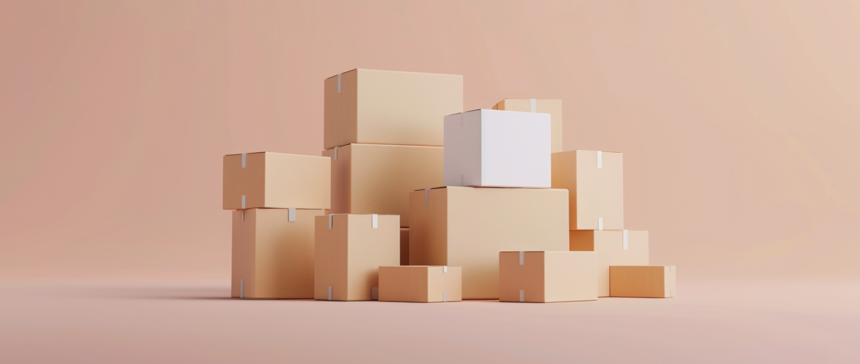Running an online business has glamorous moments, but fulfillment isn’t typically one of them. However, it’s a critical part of selling online. Fulfillment is the strategy behind getting orders from your warehouse into your customers’ hands.
You have two options for fulfillment: handling it yourself or outsourcing the process to a fulfillment service. Each approach has pros and cons, detailed in this article along with best practices to optimize your fulfillment process and avoid delays.
What is fulfillment?
Fulfillment refers to the process of preparing and delivering a customer’s order. While large enterprises and catalog companies are often equipped to handle customer order fulfillment in-house, many ecommerce companies and smaller businesses outsource this aspect of their operations to companies specializing in ecommerce fulfillment.
Types of fulfillment services
In-house fulfillment
Self-fulfillment means you’re responsible for fulfilling customer orders. You’ll need facilities, including storage space, and warehouse centers, and fulfillment teams to pick, pack, and ship products to your customers.
The ecommerce fulfillment process typically looks like this:
- Receive order: The order is received from the customer, most often through your ecommerce site, and entered into the fulfillment system.
- Pick and pack: The items ordered are picked from the warehouse and packed into boxes.
- Invoice: An invoice is created for the customer.
- Ship: The order is shipped to the customer.
- Confirm delivery: The customer is notified of the delivery and is asked to confirm receipt.
- Close order: The order is marked as completed in the system.
An advantage of in-house order fulfillment is having control over your processes. You can set your quality standards and ensure they’re maintained while gaining greater insight into your inventory. Stores with low order values tend to go this route since paying services a fulfillment fee doesn’t make sense. Simply buy discounted shipping labels through Shopify Shipping and turn a bigger profit on each order.
That said, self-fulfillment is resource-intensive. You’ll need technology to monitor inventory and pick orders and the space to do so. This can get expensive: the price of warehouse storage has skyrocketed by 20% in the past year alone.
Third-party logistics
For many small businesses, the decision to outsource order fulfillment comes down to time—not just whether they have the time to prep and ship customer orders, but whether they can do so consistently in a timely manner.
Does your business have the warehouse space to stockpile quantities of your product(s) to satisfy customer demand? Or could that space be put to better use? In either case, it might make more sense to outsource fulfillment to a third-party logistics (3PL) service like the Shopify Fulfillment Network. It integrates your store with Flexport, a global supply chain and logistics provider that will take care of the following:
- Warehousing, or storing, the product or its components.
- Producing or assembling the product, such as photocopying pages of a binder of materials or copying a CD to be mailed out.
- Packing the order in an envelope or box.
- Labeling the order for shipment.
- Shipping it using a major carrier, such as FedEx, UPS, or the US Postal Service.
- Notifying the customer via email that their order is on its way.
- Processing payment and transferring funds to the business.
“One of the biggest challenges I had starting was moving my shipping operation from my studio apartment … to an actual warehouse,” says Nancy Twine, founder of Briogeo. “I couldn’t palletize cases of products at home, and I needed support with that. So that was a big obstacle I had to navigate early on, which was starting to professionalize a lot of my operations.”
Dropshipping
The dropshipping business model means you don’t have to touch any of your inventory. Instead, you’ll promote existing products through your online store and work with dropshipping suppliers. They pick, pack, and ship orders whenever a new one comes through your website.
Dropshipping is a popular type of fulfillment because it’s low cost. You pay only for the product and any associated fulfillment costs when you’ve received payment from your customer. This lack of overheads can sacrifice margins, but it is worth it to time.
However, the biggest downside to dropshipping fulfillment is you have no control. The dropshipping supplier chooses how your products are packaged and shipped and how long they take to be delivered. A supplier that doesn’t prioritize these aspects could contribute to negative customer experiences.
Key components of a fulfillment system
Shipping a customer’s order often involves more than simply putting it in a box and dropping it off at the post office. To manage fulfillment most efficiently, you’ll need a system that offers the following key components:
- Warehousing. You need a place to store your inventory. Your warehouse management system should be able to track incoming shipments, integrate with shipping carriers, and assign tasks to warehouse workers who will pick products to pack.
- Inventory management. Gain clarity on your inventory quantities and locations with an inventory management system that integrates with your fulfillment tool. This can help prevent stockouts and excess inventory.
- Order processing. This includes printing packing slips, selecting the correct box size, and marking orders as complete as they leave the warehouse.
- Logistics. The fulfillment process doesn’t end when an item leaves the warehouse. Ensure your system supports last-mile delivery with features like carrier selection, route optimization, and real-time shipment tracking.
- Returns management. Returns are an inevitable part of ecommerce. Check that your fulfillment system can track incoming shipments, reference your returns policy to confirm item eligibility, issue customer refunds, and relist approved items as available inventory.
Choosing the right fulfillment partner
Scalability
Can your business consistently deliver the same reliable quality of finished product to customers? Or would a fulfillment specialist be better equipped to handle that?
If you suddenly experience an influx of online orders or your business goes viral, consider whether you have the resources to produce, pack, and ship all the orders quickly enough to satisfy customers. Sometimes, handing over the entire process and responsibility to a 3PL company specializing in fulfillment makes more sense. They can help improve operational efficiency without requiring you to invest significant time and money into building your system.
Technology integration
Look for a fulfillment partner with technology that integrates seamlessly with the tools you already use. This reduces the risk of human error, and outsourcing order fulfillment to a partner can also prevent stockouts by alerting you when inventory falls below a specific safety stock level in your 3PL warehouse.
“We had little to no experience in fulfilling our DTC orders successfully, but Shopify Fulfillment Network made getting started easier than ever,” says Adam Besheer, co-founder of Greenery Unlimited.
“Their app is directly integrated with our Shopify store and POS system, which allows us to take a ’set it and forget it’ approach to fulfillment. We can trust that our inventory will ship on time, be where it said it would be at any stage of the shipping process, and arrive to our customers in under three days. The value provided by SFN simply can’t be beaten.”

Cost
Before adding fulfillment to your list of business expenses, get clear on what your shortlisted vendors charge for and how much it costs. Any money you spend on fulfillment services will eat into your profit margins.
Fulfillment costs are typically categorized by:
- Setup fees: This covers the time your new provider will spend integrating your technology with theirs, syncing inventory, and storing the first batch of stock.
- Storage fees: Usually priced per pallet or cubic foot.
- Receiving fees: How much they change to accept and organize new inventory.
- Picking and packing fees: The cost of labor and any packaging materials.
- Shipping fees: The price of shipping labels to get your orders out of their warehouse.
Some providers also have minimum monthly requirements to use their services. If you fail to meet this threshold, you could end up paying an additional fee, so verify that you can meet these requirements before signing a contract with a logistics company.
Capabilities
Each fulfillment house has different capabilities. Some can print and assemble binders, books, and packets or burn CDs and DVDs, while others can warehouse completed products and ship them as ordered.
Some fulfillment services also have limitations on a product’s weight, size, or fragility. For example, if you’re shipping heavy items like furniture or delicate artwork, confirm your shortlisted partners have the infrastructure to fulfill customer orders of this type in their distribution center.
Technology in fulfillment operations
Technology allows you to speed up fulfillment operations and create a centralized place for your order-related data. The most essential apps to include in your tool stack are:
- Warehouse management software (WMS). A WMS manages every aspect of your warehouse or distribution center. It can help you locate inventory, optimize storage space, generate packing lists, and assign tasks to your warehouse staff.
- Automation. You don’t have to complete fulfillment-related tasks manually. Apps like Shopify Flow can create rules so that when a trigger occurs (like a customer paying for expedited shipping), you can automate an action (like notifying your 3PL company to prioritize this order).
- Artificial intelligence (AI). AI uses machine learning to spot trends and complete tasks. It can predict future demand, optimize stock levels, and route orders to specific fulfillment centers based on proximity and available inventory.
- Barcode systems. When a product comes into your warehouse, assign it a unique barcode label. This makes fulfillment easier because you can use barcode scanners to track inventory levels and retrieve product information, like storage locations.
- RFID technology. Considered a step above barcoding, RFID technology uses radio waves to track your inventory’s location. RFID scanners can detect multiple items at once and don’t require a direct line of sight, making them more efficient for larger warehouses fulfilling multiple orders simultaneously.
Fulfillment challenges and solutions
Inventory management
Stockouts and overstocking are two major challenges for any ecommerce business. Stock too many units, and you’ll end up paying more in storage fees, but stock too little, and you could drive customers to competitors with the item in stock.
Inventory management systems (IMS) show how much inventory you have on hand. Most allow you to set restock alerts to get notified when running low. You can also analyze inventory data like sell-through rate and time on the shelf to prioritize replenishment and avoid tying up too much capital in slow-moving products.
“We use Shopify’s native inventory management capabilities to track our production as it moves from our manufacturing facility to the fulfillment center,” says Jenni-Lyn Williams, founder of Snarky Tea. “We also use it to manage all components on our kitted items and sampler sets. It’s a game changer and keeps us from spending $250+ a month on an outside system.”
As you expand your business, it often becomes more efficient to store inventory in warehouses closer to your customers. This distributed strategy cuts down on delivery times and gets your products closer to buyers, but requires careful planning when managing inventory across multiple locations.
The last thing you want is to promise a customer two-day delivery only to experience a delay because your IMS showed the product was available in three distribution centers—but not the one closest to the customer.
A simple fix is to use an IMS that pools data from multiple warehouses. Stocky is a great example. It integrates with Shopify, including Shopify POS, so you can run regular inventory audits, confirm how much inventory you have, and pinpoint its exact location.

Order accuracy
Order accuracy rate tells you how many items were correctly picked and packed. This figure needs to be as close to 100% as possible. The higher it is, the fewer hassles you’ll have to deal with when correcting orders. Customers won’t get frustrated about receiving the wrong item, and you won’t have to pay extra inventory and shipping costs to send a replacement.
Simple ways to improve ecommerce order accuracy and operational efficiency while order picking include:
- Generating automated packing slips—a list of items that must be included in the order.
- Building a designated shipping station so you don’t mix picked items with unsold inventory.
- Placing an order fulfillment checklist beside each packing station.
- Using warehouse technology like robotic order pickers to prevent human error.
- Relying on RFID scanners to confirm that each box has the required items (without opening the box).
Efficiency and productivity
Every warehouse—whether it’s one you own or one you’ve outsourced fulfillment to—has a maximum capacity. The more efficient the fulfillment process is, the more you can push the limits of this maximum capacity without expanding the space or hiring new staff.
Poorly designed fulfillment workflows can also be to blame for inefficiencies. As much as we might try to get things right, human error often creeps in, causing shipping delays and forcing you to spend time rectifying mistakes.
The most productive way to improve fulfillment efficiency is through automation and integrations. Your ecommerce platforms, order management software, and fulfillment centers should all be in harmony. When your tools can talk to each other without manual intervention, you can reduce labor costs, pick orders faster, and prevent issues like stockouts from halting fulfillment altogether.
Regulatory compliance
International shipping presents a new set of challenges, particularly regarding regulatory compliance. Each country has its own set of rules, including import and export restrictions, labeling requirements, and tax laws. Your fulfillment process needs to be able to handle these curveballs to prevent items from being sent back or levied with extra penalties.
Shopify Shipping can help you navigate the complexities of international fulfillment. You can save up to 88% on international shipping labels, and the software will automatically generate customs forms and documentation to speed up the fulfillment process. You’ll have exactly what you need, ready to ship international orders without a hiccup.

Impact of fulfillment on customer experience
Every aspect of your ecommerce company should be underpinned by the goal of delivering excellent customer experiences. Studies have proven that people spend more with brands that offer a positive customer experience.
With a streamlined fulfillment strategy, you can:
- Boost customer satisfaction. Online shoppers expect their orders to be delivered within two to three days. The more efficient your fulfillment processes are, the more likely you are to meet customer expectations for timely delivery.
- Increase repeat purchases. A staggering 17% of customers will abandon a retailer after just one negative experience. Simply meeting—not even exceeding—their expectations can foster brand loyalty and help you earn more revenue from repeat customers.
- Pass on discounted costs. Extra fees, including shipping and taxes, are the reason behind 48% of all abandoned carts. By partnering with fulfillment companies that offer discounted shipping rates, you can pass those cost savings onto your customers and retain more people at checkout.
“For customer experience purposes, I was annoyed that our shipping tool was buggy sometimes and didn’t sync with order status in real time with Shopify,” says Simon Paquin, director of digital marketing at Pilgrim. “It started to create friction between our warehouse team and customers who had requested something from our CX team. Therefore, I began to envision how we could streamline everything.”
Outsource the entire process with Shopify Fulfillment Network
Order fulfillment is a critical part of ecommerce, but that doesn’t mean you have to handle it all yourself. With Shopify Fulfillment Network, you can outsource the entire process to the experts. Shopify Fulfillment Network connects your online store with Flexport, a leading logistics partner that will pack, pick, and ship online orders to your customers without any intervention.
Don’t just take our word for it. Greenery Unlimited’s Adam Besheer says that Shopify Fulfillment Network “brings simplicity and accuracy to every stage of the fulfillment process—from picking to packing to shipping and everything in between. Choosing SFN as your fulfillment partner will be your best decision as an entrepreneur.”
Fulfillment FAQ
What is fulfillment in business?
Order fulfillment covers the entire process, from the moment a customer places an order to the moment that order arrives on their doorstep. This includes picking the product from your inventory, packaging it securely, and handing it off to a shipping carrier to deliver it to your customer.
What is the fulfillment process?
The order fulfillment process involves several key steps: picking the ordered items from your warehouse shelves, carefully packaging them for safe transport, and shipping the package via a trusted carrier. This process typically begins with printing a packing slip and locating each item in your warehouse, and ends with passing the packed order to your chosen delivery service.
Why is fulfillment important in ecommerce?
A smooth, efficient fulfillment process is crucial for improving customer satisfaction in ecommerce. By optimizing your systems for speed and accuracy, you can significantly reduce the time customers take to receive their orders—a key factor in a world where shoppers have become accustomed to next-day delivery.
What is the difference between shipping and fulfillment?
While shipping and fulfillment are closely related, they’re not the same. Shipping refers specifically to transporting goods from one location to another, such as from your warehouse to your customer’s home. Fulfillment, on the other hand, encompasses the entire process of delivering orders to customers, from picking and packing to shipping and even handling returns. Think of shipping as one essential component of the broader fulfillment process, including critical steps like customer service, order tracking, and reverse logistics.




